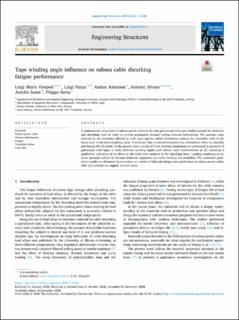| dc.contributor.author | Viespoli, Luigi Mario | |
| dc.contributor.author | Panza, Luigi | |
| dc.contributor.author | Johanson, Audun | |
| dc.contributor.author | Alvaro, Antonio | |
| dc.contributor.author | Soma, Aurelio | |
| dc.contributor.author | Berto, Filippo | |
| dc.date.accessioned | 2021-01-29T13:38:42Z | |
| dc.date.available | 2021-01-29T13:38:42Z | |
| dc.date.created | 2020-12-01T14:53:12Z | |
| dc.date.issued | 2020 | |
| dc.identifier.issn | 0141-0296 | |
| dc.identifier.uri | https://hdl.handle.net/11250/2725391 | |
| dc.description.abstract | A fundamental component of subsea power cables is the thin galvanized steel tape winded around the dielectric and sheathing layer in order to prevent permanent thermal cycling induced deformation. The pressure state induced by the resistance offered by such tapes against radial reformation reduces the triaxiality ratio of the stress state of the lead sheathing layer. It is known that a reduced triaxiality has a beneficial effect on ductility and fatigue life of metals. In the present work a series of finite element simulations are performed in presence of galvanized steel tapes at three different winding angles and without such reinforcement at all, obtaining a qualitative indication of its effect on the stress state induced in the sheathing layer. Loading conditions as internal pressure related to thermal dielectric expansion and cable bending are modelled. The numerical qualitative results are discussed in connection to a series of full-scale fatigue tests performed on subsea power cables with and without the support of steel tapes. | en_US |
| dc.language.iso | eng | en_US |
| dc.publisher | Elsevier | en_US |
| dc.rights | Navngivelse 4.0 Internasjonal | * |
| dc.rights.uri | http://creativecommons.org/licenses/by/4.0/deed.no | * |
| dc.title | Tape winding angle influence on subsea cable sheathing fatigue performance | en_US |
| dc.type | Peer reviewed | en_US |
| dc.type | Journal article | en_US |
| dc.description.version | publishedVersion | en_US |
| dc.source.journal | Engineering structures | en_US |
| dc.identifier.doi | 10.1016/j.engstruct.2020.111660 | |
| dc.identifier.cristin | 1854886 | |
| dc.description.localcode | 2020 The Author(s). Published by Elsevier Ltd. This is an open access article under the CC BY license (http://creativecommons.org/licenses/by/4.0/) | en_US |
| cristin.ispublished | true | |
| cristin.fulltext | postprint | |
| cristin.qualitycode | 2 | |

